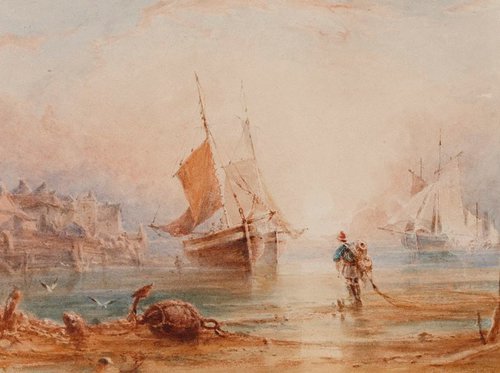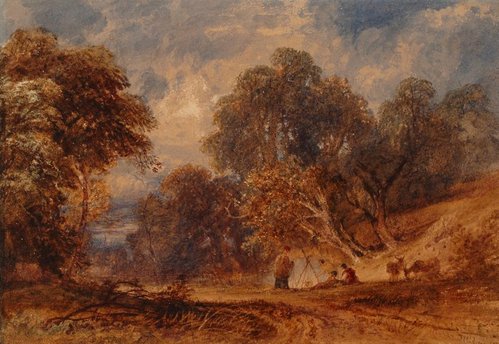Copley Fielding
England
Born: Sowerby Bridge, West Yorkshire, England 22 Nov 1787
Died: Worthing, Sussex, England 03 Mar 1855
Biography
Anthony Vandyke Copley Fielding was born into a family of artists, his flowery name (after the painters Anthony van Dyck and John Singleton Copley) effectively setting the direction of his life’s course. He first studied with his portrait-painter father before becoming a student of John Varley. An irrepressible exhibitor with the Society of Painters in Water Colours, Fielding was elected an associate in 1810, a full member in 1811, and president in 1831. He was honoured with a gold medal at the Paris Salon in 1824 alongside John Constable and Richard Parkes Bonington.
A proficient and prolific artist, Fielding assimilated the dominant romantic style of watercolour painting in flat, transparent washes. He was known principally for his scenes of shipping off British coasts, an increasingly popular subject for artists and patrons in the early 19th century, which earned him considerable financial success.
Inspired by a nautical misadventure in the treacherous passage through the Eddystone Rocks near Cornwall, Off the Eddystone – effect of storm typifies Fielding’s large-scale exhibition work, and was favourably appraised by the critic of The Literary Chronicle in 1827:
‘It is a picture deep in tone without blackness, and effective from its simplicity. The elements are in commotion, and the perilous occupation of the intrepid mariner excites our sympathy, without the fallacious aid of preternatural effects of sea and sky. It is, indeed, a veritable picture of this well-known scene of skilful pilotship, and cannot fail to be viewed with commensurate interest by all those who have experienced a gale off this fearful coast.’
John Ruskin, in his autobiography Praeterita (1885–89), recalled his boyhood lessons in watercolour under Fielding, who ‘taught me to wash colour smoothly in successive tints, to shade cobalt through pink madder into yellow ochre for skies, to use a broken, scraggy touch for the tops of mountains … to produce dark clouds and rain with twelve and twenty successive washes, and to crumble burnt umber with a dry brush for the foliage and foreground.’
Fielding was particularly adept at capturing such evanescent effects as rain, spray and clouds. In Stranded – morning after the wreck, broad sponging with dark blue-grey evokes the drama of the sky, while scratching through the surface of the paint to reveal the white of the paper beneath suggests the sea foam and waves.
Despite his merits, however, Fielding came to be viewed by some critics as a painter of formulaic set pieces; even Ruskin, who heartily championed his work, felt compelled to qualify his endorsement of the artist in the first volume of Modern painters (1843): ‘he produced some of the most perfect and faultless passages of mist and rain-cloud which art has ever seen… Had he painted five instead of five hundred such, and gone on to other sources of beauty, he might, there can be little doubt, have been one of our greatest artists.’
Victorian watercolours, Art Gallery of New South Wales, Sydney 2017




